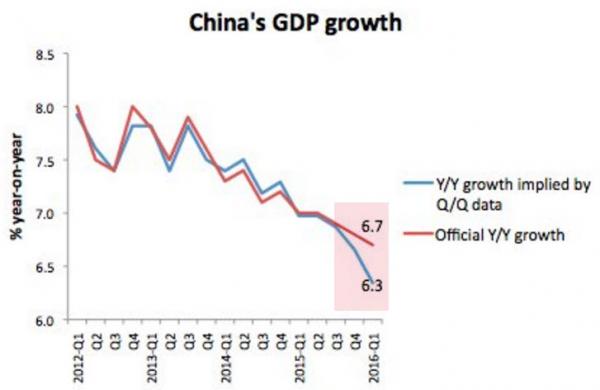Why China matters so much to the Fed
When the Federal Reserve triumphantly raised interest rates in December for the first time since 2006, it did so over the objections of America's trading partners -- especially China. The Fed moved amid proclamations that it was focused on setting policy for the U.S. based on a tightening job market and stabilizing inflation.
Fast-forward a few months, and the drums are hammering out a different beat.
A rising concern for Fed officials is the health of the Chinese economy, which, despite a headline growth rate of 6.7 percent for the first quarter, remains vulnerable. The Fed and China have been the focus of chatter about a possible under-the-table agreement at the Feb. 27 meeting of G-20 nations to weaken the dollar to help stabilize the Chinese economy.
If that's the case, it suggests that what happens in the Middle Kingdom will have a big influence on where U.S. interest rates go later this year.
The Fed mentioned downside risks to China six times in its Jan. 26-27 policy meeting, after citing them three times at the March 15-16 meeting. And Fed Chair Janet Yellen singled out China and the country's currency in her March 29 speech before the Economic Club of New York, which in retrospect was a big catalyst for the recent stock market upswing:
"One concern pertains to the pace of global growth, which is importantly influenced by developments in China. There is a consensus that China's economy will slow in the coming years as it transitions away from investment toward consumption and from exports toward domestic sources of growth. There is much uncertainty, however, about how smoothly this transition will proceed and about the policy framework in place to manage any financial disruptions that might accompany it. These uncertainties were heightened by market confusion earlier this year over China's exchange rate policy."
That's a lot of focus on China for an official who's supposed to be preoccupied, and setting policy, based on what's happening in the U.S. Of course, Yellen isn't the only one with China on the brain. International Monetary Fund chief Christine Lagarde mentioned China five times in a speech earlier this month, warning that its economy is slowing.
Since late February, China's Shanghai Composite stock index has bottomed and rallied more than 11 percent. The U.S. dollar index has weakened by nearly 5 percent over this period, threatening to push the greenback out of its post-2014 trading range. Regardless of whether a "Dollar Accord" was agreed to, the evidence suggests something has indeed changed.
Why the intense focus on China?
Because people are beginning to realize just how sensitive that country's already vulnerable economy is to a strengthening dollar. The problem is the Chinese economy's reliance on dollar-denominated foreign debt. Those securities were a great deal when the dollar was stable and cheap between 2005 and 2014 as China's yuan rose. But that debt has become increasingly expensive and painful as the dollar soared (and the yuan fell) from mid-2014 to early 2015 on Fed rate-hike expectations.
The Bank for International Settlements estimates that emerging markets are holding $4 trillion worth of the stuff -- a 400 percent increase since 2008. China owns a quarter of that total.
The good news -- if China's official economic data is to be believed -- is that things are improving. The country's industrial production rose a better-than-expected 6.8 percent in March, hitting a level not seen since June 2015. First-quarter GDP growth clocked in at an in-line result of 6.7 percent.
The bad news is that other evidence suggests ongoing fragility. Freight activity is falling to new lows, down nearly 50 percent over the last two years. Credit growth remains frighteningly high, with $500 billion in new loans issued so far this year, equal to about 7 percent of China's GDP and up 25 percent from last year. New home prices in "Tier 1" cities are rising at a nearly a 30 percent annual rate, exceeding prior bubble highs.
Analysts at CBB International also note that the labor market is slowing, with job growth falling in the first quarter for the second consecutive period, hitting a four-year low in the process. Capital spending remains weak as well.
The ugly news is that some evidence shows China is doctoring its GDP numbers, as Bloomberg Intelligence reports the quarter-over-quarter data suggest first-quarter GDP growth was just 6.3 percent -- below the 6.7 percent year-over-year number. This could be just seasonal adjustments gone awry. But the impression is that Beijing is trying to control emotions at this fragile time as it busily injects stimulus into its economy.
Moreover, an odd 116 percent year-over-year surge in Hong Kong exports to China suggests over-invoicing as Chinese citizens try to hide capital outflows on fears of further declines in the yuan.
Watch for Yellen and her Fed cohorts to say more about China when their next policy statement is released on April 27. Until a Chinese turnaround is well established, U.S. interest rates probably aren't going anywhere.

